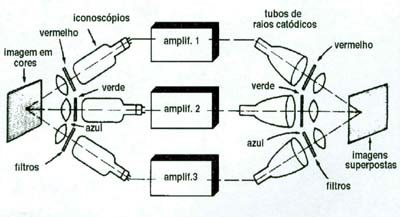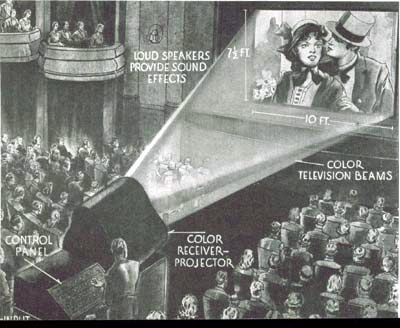 |
| (a) Schematic of the transmission and
reception of color video signals. |
Once the black and white television
technology had been solved, around 1954 in the USA, the electronic
industry began to take interest in the development of a reliable
colour television system.
Basically the transmitter comprised a set of dichroic mirrors
breaking the acquired image in the three primary colors: green,
red and blue, whose beans were simultaneously, projected over
three television cameras. (a)
Then, by using a package of two compounded and combined signals
known as luminance and chrominance, transmitted the colored
images.
In reality the luminance is the black and white signal while
the later is responsible for the image hue, which is modulated
in a additional carrier as known as chrominance sub-carrier,
whose operating frequency is higher than the former signal
to avoid as much as possible any kind of interference.
 |
| Large screen all-electronic color television
sytem as presented by RCA at the Franklin Institute in
the USA, circa 1947. (Radio News) |
However, at the receiving end the optical composition of the
three colored images was a difficult task. In this way, to
overcome such problem the engineers invented the cathode ray
tube that could reproduce the complete colored images.
Such a kind of cathode ray tube was developed considering
a phenomenon in which dots or lines in the three colors placed
close together are seen as a mixed color.
The first type of such a kind of cathode ray tube, known as
shadow mask tube, was launched in the American market by RCA.
In the shadow mak tube a metal plate containing thousands
of dots was placed between the three cathodes and the fluorescent
screen. The screen itself consists in a pattern of many red,
green and blue dots. When the three-color electron beam from
the cathode, lands on a dot over the mask, for instance the
one modulated for the red hit the red dot, and so in a succeeding
manner for each color.
The three-color beams are deviated simutaneously by the deflecting
coils in such away the three images, one for each color are
produced continuously.
Nowadays, the colored television is a means of communication
with a lot of application in home, as well as in scientific
and industrial fields whose fast and fantastic evolution was
followed by another important technological development: the
recording of the video signals.
|